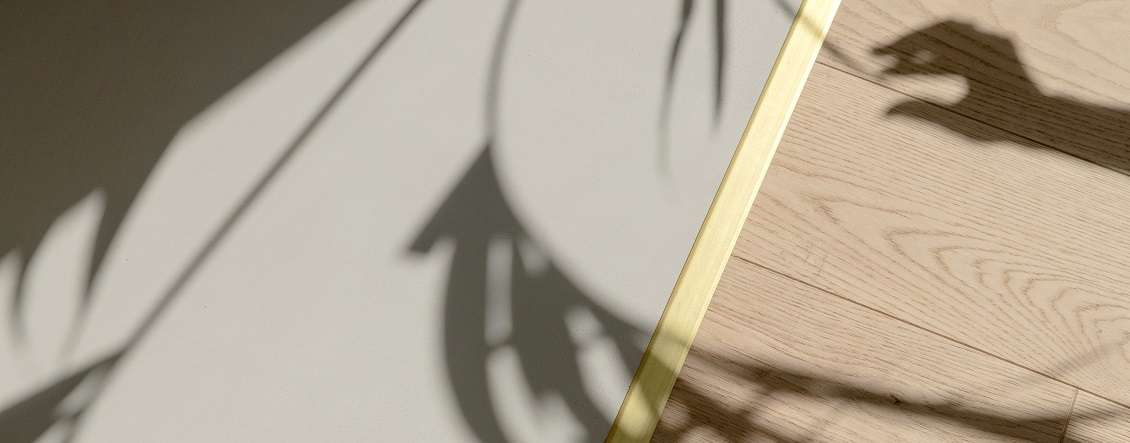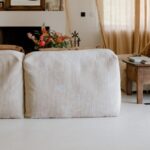Concrete varnishes and impregnations – wall varnish, fixative, filler & application tips
The company’s history began 40 years ago with cleaning and protective coatings. These were public works such as subways, noise barriers, high schools, bridges…
This experience has made Marius Aurenti a key player in the protection of public works, and over the past 30 years in commercial and private projects.
The company has carried out numerous waxed concrete projects on floors and walls, bathrooms, kitchens, terraces… protected by waxes, then mineralizers, lasures and varnishes.
Types of varnish
Every type of concrete needs its own varnish: water-based or solvent-based?
Each surface and use has its own solution, in keeping with respect for materials and the desire for a mineral, raw aesthetic.
For waxed concrete or panel applications, the water-based range offers excellent performance for low-demand areas, while solvent-based varnishes remain the ultimate protectors for the most demanding areas.
A+ rating
Marius Aurenti varnishes are A+-rated, recognized by professionals and extremely resistant to chemical or physical aggression, requiring little maintenance.
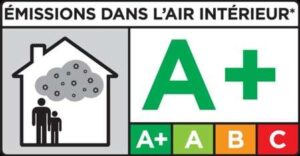
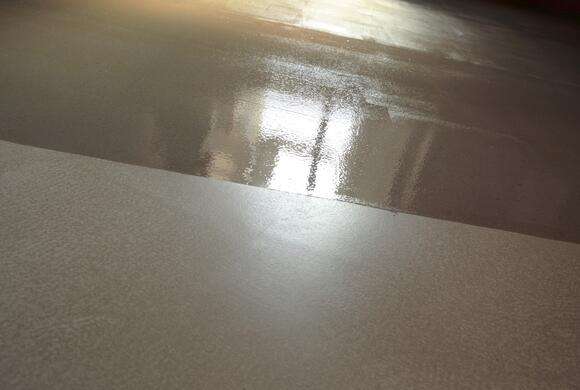
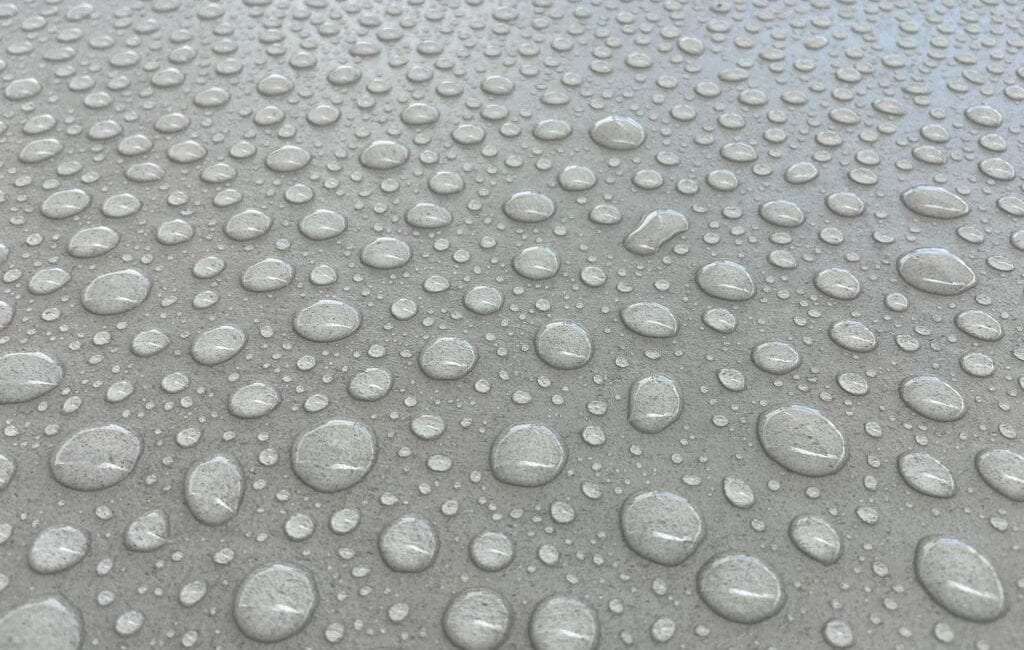
The Marius Aurenti varnish range
Varnishes and impregnations
The varnish range includes :
- A single-component concrete wall varnish.
- A special impregnation for terraces.
- A two-component, aqueous-phase n°7 varnish with filler for interior floors and walls.
- An IF3 two-component solvent-based impregnation for the most demanding applications.
Varnish application
The application of a varnish requires particular care (temperature and humidity conditions, ventilation, quality of mix, drying time between coats, quantity, tools and user protection).
Consult the technical data sheets for each varnish and ask our teams for advice on the best protection for your project.
Read the technical data sheets carefully and take part in professional training courses.
Wall protection varnish n°2
Single-component, waterborne varnish.
Easy to use, it protects walls made with Béton Mural Marius Aurenti or Béton ciré Classic on walls outside wet rooms.
Quick-drying and chemically resistant, it provides good protection when cleaning (washing) decorative walls. Unique silky-matt finish.
Consumption: 75 g/m² in 1 coat, apply 2 coats for extra protection.
Packaging: 1 kg and 5 kg
Bouche Pore n°5
Water-based protection for floors and walls. It regulates the porosity of waxed concrete before applying VISCO N°7 varnish.
Average consumption: 100ml/m² in 2 coats.
Apply with a microfiber roller (10mm)
VISCO Varnish n°7
Colorless, two-component, waterborne polyurethane-based topcoat.
High chemical resistance.
It fills the pores of waxed concrete and gives it a natural finish.
It protects interior walls and floors in Marius Aurenti waxed concrete in everyday living areas.
Matt or satin finish.
Consumption: 250 to 300 g/m² in 2 to 3 coats
Packaging: 1 kg and 5 kg
Varnish Fixative IF3
High-performance impregnation for interior floors and walls in dry and damp areas for residential and commercial use.
Two-component polyurethane varnish.
This fixative acts as a pore filler and finish in a single product.
It allows coats to be applied every 3 hours, for a complete treatment in a single day.
Its matte or silky-matte appearance and properties make it ideal for protecting concrete subjected to intensive use: bathrooms, floors, walls, furniture, kitchens and public areas.
Consumption: 300 g/m² in 3 to 5 coats.
Packaging: 1.1 l and 5.5 l.
Impregnation Terrace
Ideal for use on Classic, Fluide or Special Terrace waxed concretes, this solvent-based impregnation protects outdoor floors.
Its pearlizing effect prevents the penetration of water and greasy products.
It facilitates the maintenance of your floor coverings.
Satin finish.
Consumption: 250 g/m² in two coats.
Packaging: 5 l.
Technical data sheets (PDF version)
Technical data sheets (web version)
Presentation
AREAS OF USE
Protecting and decorating interior walls
COMPOSITION
Single-component, waterborne varnish
PROPERTIES
Transparent, non-yellowing, good adhesion, quick-drying, odorless.
PACKAGING
1 kg and 5kg
Implementation
SUBSTRATE AND SUBSTRATE PREPARATION
Perfectly consistent, clean and dry concretes and derivatives Sand varnished concretes to 120 grit for refinishing
CONSUMPTION
Indicative data which may vary according to application conditions and the porosity of the substrate. 75 grams per m² in 1 coat
DILUTION
No
APPLICATION EQUIPMENT
Lacquer roller. The equipment must be perfectly dry and clean.
APPLICATION METHOD
Shake well before application.
To avoid roller marks, it is advisable to always work cool in cool.
CONDITIONS OF APPLICATION
TEMPERATURE >10°C and <35°C (ideal temperature: >15°C and <20°C)
RELATIVE HUMIDITY <80%
HUMIDITY OF SUBSTRATE 4% maximum
DRYING TIME AT 20°C AND 60% RELATIVE HUMIDITY
DRY TO THE TOUCH 30 minutes
RECOVERABLE after a minimum of 4 hours and a maximum of 8 days. Beyond that, light sanding is required
COMMISSIONING WITH PRECAUTIONS 24 hours minimum
DEFINITIVE DURATION 4 days minimum
TOOL CLEANING
Equipment should be cleaned with water immediately after use.
Technical specifications and performance
PRODUCT APPEARANCE
Colorless viscous liquid
FINISHED ASPECT
Silky matte transparent film
DENSITY (AT 20°C)
1
SPECULAR GLOSS AT 60°.
Silky matte: approx. 6 UB
These data are indicative and may vary according to application conditions.
PRECAUTIONARY MEASURES
The role of varnish is to avoid and prevent stains on porous materials such as concrete or stone.
Despite the high performance and qualifications of MA’s treatments, these protections are not insensitive to long and repeated exposure, which can damage the material.
Avoid prolonged or permanent contact with aggressive chemicals such as acids, alkalis, vinegar, solvents, bleach, etc.
These varnishes are not recommended for use in contact with hot oils (e.g. kitchen splashbacks).
Wall protection varnish may only be used on walls.
STORAGE AND SAFETY
1 year in original packaging, away from sunlight and frost, in a cool, well-ventilated place. Check the expiry date on the packaging before use.
For further safety information, please consult the Safety Data Sheet. VOC contents are also available in section 15 of the Safety Data Sheet.
Technical data – MAJ 22/10/19
Pore plug n°5
Presentation
Areas of use
Protecting interior walls and floors
Composition
Aqueous phase pore sealers
Properties
Transparent, non-yellowing, regulates slightly sandy and very porous bottoms.
Excellent resistance to water and dirt.
Packaging
1 L and 5 L
Implementation
Substrate and substrate preparation
Concrete, mortar, dry mineral coatings
Application conditions
Temperature: 10-30°C
Relative humidity: <80%
Protect from wind, sun and frost during application and curing.
No dilution required
Application material
Microfiber roller, spray gun
Application method
Shake before use.
Apply to saturation (generally in 2 coats) in criss-cross passes.
Consumption
100g per m² in 2 coats
Indicative data to be adapted according to the porosity of the substrate
Bouche-pore n°5 naturally has a slight residual surface tack. Excessive use of pore-filler can accentuate this residual surface tack.
Drying time at 20°C and 60% relative humidity
Between coats: approx. 6 hours (depending on the porosity of the substrate)
Completely dry: 24 hours minimum. Do not varnish before 24 hours
Tool cleaning
Water
Technical specifications and performance
Product appearance
Appearance in jar: milky liquid
Finished appearance: transparent, colorless satin film
Density A+B (at 20°C): 1.0 +/-0.1
Flash point: NA
Useful life: NA
Other data : –
Storage and safety
1 year in original, unopened packaging, out of direct sunlight and frost, at temperatures between +5° and 35°C.
Check the expiration date on the packaging before use.
For further safety information, please consult the Safety Data Sheet.
All information contained in this data sheet is provided for information purposes only and does not engage our responsibility. Testing is necessary.
For further information on precautions for use and safety instructions, please refer to the safety data sheet.
Presentation
AREAS OF USE
Protection and decoration of interior walls and floors (for exterior use, please consult us). Shower and worktop applications are excluded.
COMPOSITION
Two-component, waterborne polyurethane varnish.
PROPERTIES
Transparent, non-yellowing, highly resistant
PACKAGING
1 kg, 5 kg and 10 kg
Implementation
SUBSTRATE AND SUBSTRATE PREPARATION
Perfectly coherent concretes and derivatives, perfectly clean and dry epoxy and polyurethane resins. Sand varnished concrete to 120 grit for repair.
Close open supports by applying Pore Sealer n°5.
The use of Porous Sealer n°5 is also recommended on Marius Aurenti Concrete Stain, to avoid whitening when applying Varnish n°7.
APPLICATION EQUIPMENT
10 mm microfiber roller, spray gun. The equipment must be perfectly dry and clean.
CONDITIONS OF APPLICATION
It is essential to measure the ambient temperatures and relative humidities of the substrate before applying the product.
TEMPERATURE >10°C and <35°C (ideal temperature: >15°C and <20°C)
RELATIVE HUMIDITY <80%
HUMIDITY OF SUBSTRATE 4% maximum
Failure to observe these conditions may render the chemical reaction of varnish n°7 inactive. In this case, the chemical and mechanical performance of the varnish is not achieved. Bleaching may also occur.
During the entire varnish application and drying phase, the premises must not be painted.
APPLICATION METHOD
Shake component A, then slowly introduce component B while maintaining agitation. Stir for a further 3 minutes using a low-speed blender. Let the mixture stand for 10 minutes.
Apply in 2 coats. It’s important to avoid over-thickening, which could lead to a whitening effect. For this, we recommend wringing out the roller and applying the varnish in criss-cross layers. The milky appearance on application helps avoid over-thickness and gaps. To avoid roller marks, it is advisable to always work cool in cool.
Implementation
Indicative data which may vary according to application conditions and the porosity of the substrate.
Mixing chart
Mixing ratio :
A/B by weight: 65/35 for gloss
A/B by weight: 70/30 for satin finish
A/B by weight: 80/20 for matte
Dilution: 5 to 10% HR1 Varnish Thinner
| COMPONENT A | COMPONENT B | TOTAL | AREA COVERED (FOR 1 LAYER) |
|---|---|---|---|
| 0.091 kg | 0.009 kg | 0.100 kg | 1 m² |
| 0.182 kg | 0.018 kg | 0.200 kg | 2 m² |
| 0.455 kg | 0.045 kg | 0,500 kg | 5 m² |
| 0.91 kg | 0.09 kg | 1.00 kg | 10 m² |
| 4.55 kg | 0.45 kg | 5.00 kg | 50 m² |
| 9.10 kg | 0.90 kg | 10.00 kg | 100 m² |
CONSUMPTION
Indicative data which may vary according to application conditions and the porosity of the substrate. 250 to 300 grams per m² in 2 or 3 coats.
DRYING TIME AT 20°C AND 60% RELATIVE HUMIDITY
DRY TO TOUCH 2 hours
RECOVERABLE after 6 hours minimum and before 24 hours maximum
LIGHT CIRCULATION 24 hours minimum
DEFINITIVE 5 days minimum. Do not lay carpets before 7 days of drying.
TOOL CLEANING
Equipment should be cleaned with water after use.
Technical specifications and performance
POT ASPECT
Component A, component B and mixture: colorless viscous liquid
FINISHED ASPECT
Transparent and colorless matte, satin or gloss film.
Please note that the original shade can be enhanced by one or two shades.
DENSITY A + B (AT 20°C)
Components A + B: 1.23 + /- 0.03
SPOTLIGHT
> 21 °C
USEFUL LIFE (20°C, 60%)
8 to 12 hours at 20°C
SPECULAR GLOSS AT 60°.
Matt: approx. 6 UB Satin: approx. 40 UB Gloss: approx. 65 UB
These data are indicative and may vary according to application conditions.
PRECAUTIONS FOR USE
The role of varnish is to avoid and prevent stains on porous materials such as concrete or stone. Despite the high performance and qualifications of MA’s treatments, these protections are not insensitive to long and repeated exposure, which can damage the material.
It is therefore imperative not to leave standing water on varnishes which are not suitable for sealing (e.g. flowerpots, sponges, wet cloths, etc.).
Avoid prolonged or permanent contact with aggressive chemicals such as acids, alkalis, vinegar, solvents, bleach, hydroalcoholic gel…
Splashes of hydroalcoholic gel on the varnish surface can cause irreversible damage. Surfaces at risk of exposure must be perfectly protected.
These varnishes are not recommended for use in contact with hot oils (e.g. kitchen splashbacks).
MAINTENANCE
Follow the instructions in the Marius Aurenti maintenance booklet
STORAGE
6 months in original, unopened packaging, out of direct sunlight and frost, at temperatures between +5° and 35°C. Check the expiration date on the packaging before use.
SAFETY
If application is to be carried out in a closed area close to dwellings, an air extraction system should be installed to avoid any inconvenience caused by the solvent vapors contained in the varnish.
Wear appropriate safety equipment. Refer to safety data sheet.
For further safety information, please refer to the Safety Data Sheet. VOC contents are also available in section 15 of the Safety Data Sheet.
FIXED IF3 Finish
Edition of 12/12/2022
Presentation
AREAS OF USE
Fixing primer protection for interior waxed concrete walls and floors (consult us for exterior applications).
COMPOSITION
Two-component, solvent-based PU fixative.
Component A: base; Component B: hardener
FINISHES
Silky matte
PROPERTIES
Finishing product that provides the system with high mechanical strength and chemical resistance.
This product is perfectly suited for use in environments subject to high mechanical and chemical stress (floors, kitchens, bathrooms, etc.).
Its short drying time means that successive coats can be covered very quickly. This makes it ideal for small-scale, in-situ projects, minimizing the need for on-site travel.
PACKAGING
1.1 L and 5.5 L
Implementation
SUBSTRATE AND SUBSTRATE PREPARATION
MA’s waxed concretes, concretes and derivatives that are perfectly consistent, perfectly clean and dry, free of greasy stains. When repairing a varnish or fixative wear layer, sand with 120 grit.
PREPARATION
Resin/hardener mixing ratio: 10/1
Failure to observe the correct mixing ratio between resin and hardener will alter the product’s performance (chemical and mechanical resistance).
APPLICATION EQUIPMENT
10 mm microfibre roller, spray gun: 1.6-1.8 mm diameter nozzle.
CONDITIONS OF APPLICATION
It is essential to measure ambient and substrate temperatures and relative ambient and substrate humidity before applying the product.
AMBIENT TEMPERATURE 17-25°C (ideal value: 20 to 25°C)
SUBSTRATE TEMPERATURE >3° from dew point to avoid condensation
PRODUCT TEMPERATURE Ambient temperature 18-25°C (ideal value: 20 to 25°C)
HUMIDITY SUPPORT <4% relative humidity
RELATIVE HUMIDITY >40% and <80% (ideal value: 50 to 65%)
Protect from wind, sun and frost during application and setting.
Ventilate the room (provide air circulation) during application and drying to avoid surface defects in the varnish film.
Failure to observe these application conditions may render the chemical reaction of IF3 fixative inactive.
In this case, the chemical and mechanical performance of the fixative is not achieved. Bleaching may also occur.
During the entire varnish application and drying phase, the premises must not be painted.
Implementation
APPLICATION METHOD
Application in 4 coats.
Indicative data which may vary according to application conditions and the porosity of the substrate.
CONSUMPTION
Indicative data which may vary according to application conditions and the porosity of the substrate. Minimum: 300 grams per square metre
Applying too thick a coat can cause previous coats of fixative to bubble or even peel off.
DRYING TIME AT 20°C AND 60% RELATIVE HUMIDITY
OUT OF DUST 30 minutes
DRY TO TOUCH 2 hours
BETWEEN COATS 2 hours minimum, remove previous coat after 48 hours
FULL DRYING 7 days minimum.
Do not lay carpets before 7 days of drying.
At a temperature of 17°C, drying time is doubled.
To increase recovery time, add 10% of a suitable thinner (consult us).
If other trades are working on the site, we recommend the use of micro-breathable protective tarpaulins such as Landolt’s Floorliner Vapor.
TOOL CLEANING
Solvent-based cleaner
Technical specifications and performance
PRODUCT APPEARANCE
Appearance in jar: colorless liquid Applied appearance: silky matte or matte
DENSITY A + B (AT 20°C)
0.95
SPOTLIGHT
< 21°C
USEFUL LIFE
1 hour
Despite their apparent fluidity, old mixes are detrimental to the quality of IF3 fixative (adhesion, mechanical and chemical resistance). Never reuse them.
Specular gloss at 60°: silk matte: approx. 8 UB Matte: approx. 3 to 5 UB
Indicative data which may vary according to application conditions.
PRECAUTIONS FOR USE
The role of fixatives is to avoid and prevent stains on porous materials such as concrete or stone. Despite the high performance and qualifications of MA’s treatments, these protections are not insensitive to long and repeated exposure, which can damage the material.
It is therefore imperative not to leave standing water on fixatives which are not suitable for sealing (e.g. flowerpots, sponges, wet linen…).
Avoid prolonged or permanent contact with aggressive chemicals such as acids, alkalis, vinegar, solvents, bleach, hydroalcoholic gel, etc.
Splashes of hydroalcoholic gel on the fixative surface can cause irreversible damage. Surfaces at risk of exposure must be perfectly protected.
The use of these fixatives is not recommended when in contact with hot oils (e.g. kitchen splashbacks).
The use of a protective mat is necessary when using chairs with castors.
We recommend the use of protective felt under chair legs or furniture.
MAINTENANCE
Follow the instructions in the Marius Aurenti maintenance manual.
STORAGE
1 year in original, unopened packaging, out of direct sunlight and frost, at temperatures between +16° and 25°C. Check the expiration date on the packaging before use.
If application is to be carried out in an enclosed area close to dwellings, an air extraction system should be installed to avoid the unpleasant effects of solvent vapors contained in the varnish.
SAFETY
Wear appropriate safety equipment. Refer to safety data sheet. For further safety information, please refer to the Safety Data Sheet. VOC contents are also available in section 15 of the Safety Data Sheet. For further safety information, please consult the Safety Data Sheet.
Impregnation Terrace n°2
Presentation
Areas of use
Protecting concrete floors and exterior walls
Composition
Solvent-based acrylic impregnation
Properties
Prevents penetration of water and greasy products, pearlescent effect, easy maintenance, colorless, non-yellowing
Packaging
5L
Implementation
Substrate and substrate preparation
Perfectly consistent concretes and derivatives.
Clean raw concrete with MA’s New Screed Acid Cleaner and rinse to neutralize PH. Sand varnished concrete with 120 grit to repair the wear layer.
Application conditions
It is essential to measure ambient and substrate temperatures and relative ambient and substrate humidity before applying the product.
Ambient temperature: 5 – 30°c
Substrate temperature: >3° from dew point to avoid condensation
Relative humidity: <80%
Substrate humidity: <4%. A damp substrate or the presence of moisture may cause the solvent-based oil-repellent impregnation to bleach.
Protect from rain, wind, sun, frost, flora and fauna during application and setting.
Failure to comply with these application conditions may render the chemical reaction of Terrasse n°2 impregnation inactive. In this case, the chemical and mechanical performance of the impregnation is not achieved. Bleaching may also occur.
Application material
Short-haired roller, brush.
Application method
Homogenize Terrasse n°2 impregnation before use.
Apply in 2 coats. Excessive thickness can lead to defects in appearance.
Consumption
200 to 300g per m² for 2 coats, depending on the porosity of the substrate.
Indicative data which may vary according to application conditions and the porosity of the substrate.
Excessive thickness of Terrasse n°2 impregnation (too thick a layer) can lead to bubbling or even delamination of previous impregnation layers.
Drying time at 20°C and 60% relative humidity:
Dust-free: 30 minutes
Between coats: 5 hours minimum, remove previous coat after 24 hours
Completely dry: 24 hours minimum.
If other trades are working on the site, we recommend the use of micro-breathable protective tarpaulins such as Landolt’s Floorliner Vapor.
Tool cleaning
Epoxy and polyurethane cleaner
Technical specifications and performance
Product appearance
Appearance in jar: Clear liquid
Finished appearance: Transparent, colorless film, silky matte to satin finish. Please note that the original shade can be enhanced by one or two shades.
Density A+B (at 20°C)
0,9
Precautions for use
The role of Terrasse n°2 impregnation is to avoid and prevent stains on porous materials such as concrete or stone. Despite the high performance and qualifications of MA’s treatments, these protections are not insensitive to long and repeated exposure, which can damage the material.
It is therefore imperative not to leave any standing water on the covers, which are not suitable for sealing purposes (e.g. flowerpots, sponges, wet cloths, etc.).
Avoid prolonged or permanent contact with aggressive chemicals such as acids, bases, vinegar, solvents, bleach, hydroalcoholic gel, etc.
Splashes of hydroalcoholic gel on the impregnation surface can cause irreversible damage. Surfaces at risk of exposure must be perfectly protected.
Applying varnish to Marius Aurenti waxed concrete
With this tutorial, discover the best techniques for applying Marius Aurenti varnish, for optimum protection and easy maintenance.
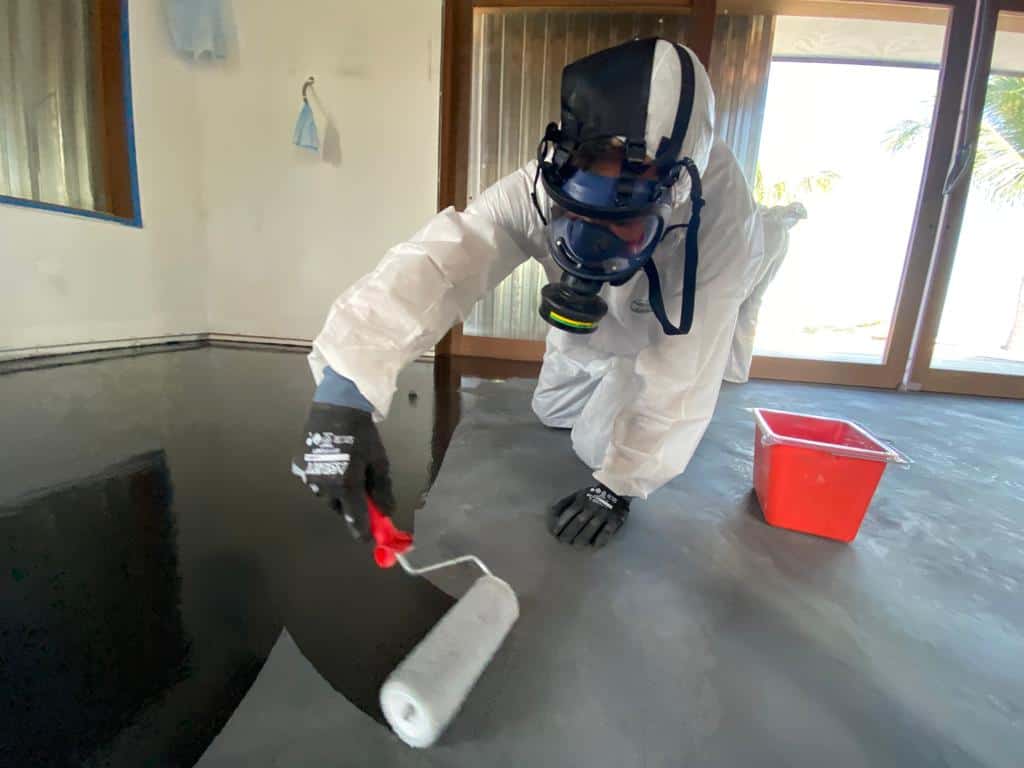
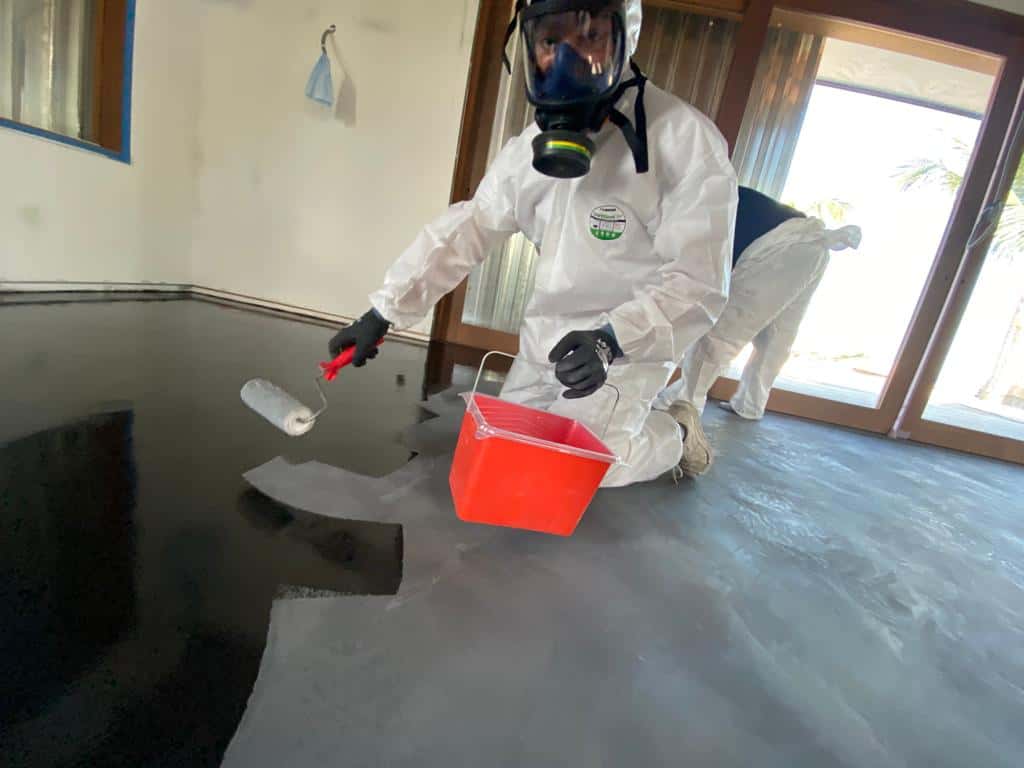
What are the key points for applying varnish correctly?
The application of a varnish is an important step in the successful creation of a waxed concrete finish.
This is what will determine the quality of your waxed concrete’s protection and facilitate its daily maintenance.
1/ Matt, satin or gloss varnish?
Start by choosing the look of your varnish: most come in matte, silk matte, satin or gloss.
Most of our work is done in silky matte or satin, as this retains a certain depth of material, while giving a pleasing finish to the eye.
Shiny finishes, on the other hand, are rarely used on mineral materials, as they give the surface a somewhat flashy appearance. However, gloss goes well with black, for example, or with red, to give a lacquered effect.
Finally, matte varnish gives the materials depth and a very contemporary raw look. It is particularly well-suited to walls to give them depth in relation to the light.
2/ How do I choose the right nail polish from the Marius Aurenti range?
For wall protection, we recommend our single-component acrylic wall varnish. Simple and effective, apply with a roller and criss-cross strokes. It provides sufficient protection against accidental splashes and allows the wall to be washed for regular cleaning.
In high-traffic areas, two-component HR1 and n°7 Visco polyurethane-based varnishes are the best choice. They include a base and a hardener.
Marius Aurenti develops water-based varnishes, but for high-traffic areas such as kitchens, bathrooms and high-traffic floors, professionals use our range of solvent-based varnishes.
These increase mechanical strength and resistance to chemical agents, and guarantee easy cleaning and longer service life.
3/ How much varnish should I use?
Once you’ve decided on the effect – matt, satin or gloss – and the type of varnish to use, you need to calculate the quantity of varnish you’ll need for your work. If, for example, you need to cover a 50 m² floor and the varnish is quoted at 250 g per square metre, you’ll need 12.5 kg of varnish. It’s important to use up all 12.5 kg of varnish, adjusting the number of coats you repeat until the entire quantity is consumed. Quantity, and quantity alone, determines the quality of protection!
As for application, avoid very thick coats. They won’t stretch very well and won’t form the film needed to protect your work.
It is therefore preferable to apply more thin coats than fewer thick ones. In addition, each varnish requires a specific drying time between coats. This time must be respected so that the new layer does not melt or technically soak the previous layer by depositing it too hastily.
4/ Good site conditions
On a building site, the temperature and humidity of the air and substrate are crucial. In fact, if you apply your varnish to concrete that’s still damp, its set will mix with the water and, once dry, the film won’t play its role in protecting against stains. It is therefore important to allow the concrete to dry, ideally 48 hours at 20° C, before applying the varnish.
Temperature also influences humidity, as it determines the speed at which the varnish sets. Ideally, you should work two days after applying your concrete, at a temperature of 20° and 65% humidity. If these conditions are not met on your site, you can use a heating or dehumidification system if necessary.
5/ Preparing the varnish
In the case of two-component varnishes, component A and component B must be mixed as indicated on the packaging. A scale is therefore necessary to prepare your mixture for a single layer. Note that solvent-based varnishes require a thin first coat with a longer drying time, usually overnight, to allow the concrete pores to be deeply sealed. Water-based polyurethane varnishes may require prior application of a pore filler.
Repeat for each coat of varnish. If you have any varnish left over after applying one coat, do not save it for the next coat, as it will have lost its stain-resistant quality.
6/ Applying varnish
When using solvent-based varnishes, make sure you have the necessary protective equipment and a special mask.
Two-component varnishes, such as HR1 or n°7 Visco, require the hardener to be thoroughly mixed with the base to ensure correct reaction. Leave to stand for five minutes before application and stir again before starting.
Before applying the first coat, it’s important to remove dust from the substrate with a vacuum cleaner, and to ensure that your worksite is dust-free between coats.
Start by applying to edges and corners using a brush or small microfiber roller. Then, for larger surfaces, use a 10 mm microfiber roller, criss-crossing the coats. A simple swipe with your hand will allow you to feel the roughness of the dust, which can be lightly sanded with 240 grit paper between coats if necessary.
Once the varnish is finished, the surface dries very quickly. It usually allows you to walk around with protective footwear on the next day, but it won’t have finished drying out yet.
Traffic is possible after three days, and a varnished surface can be wet-coated after 7 days at 20° temperature and 65% humidity.
7/ Varnishes tested and approved for over 35 years
Marius Aurenti varnishes are recognized by professionals, and have been used for over 35 years in public buildings, residential settings and intensive-use establishments.
They are extremely durable and require very little renovation. A good regular cleaning system will ensure their longevity, and they can also be polished with sanding tools in the event of micro-scratches.
If, after several years, you wish to renovate your surface, you can do so by lightly sanding it with 120 grit after stripping, and renewing one to three coats of varnish if necessary.
One last point: check the freshness of the varnishes and their storage conditions, to avoid freezing and extreme heat.
Good application, your job is almost done!


